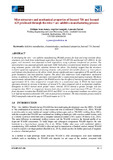JavaScript is disabled for your browser. Some features of this site may not work without it.
| dc.contributor.author | James, William Sean | |
| dc.contributor.author | Ganguly, Supriyo | |
| dc.contributor.author | Pardal, Goncalo | |
| dc.date.accessioned | 2023-02-01T12:43:21Z | |
| dc.date.available | 2023-02-01T12:43:21Z | |
| dc.date.issued | 2022-03-05 | |
| dc.identifier.citation | James WS, Ganguly S, Pardal G. (2022) Microstructure and mechanical properties of Inconel 718 and Inconel 625 produced through the wire + arc additive manufacturing process. In: AVT-356 Research Symposium on Physics of Failure for Military Platform Critical Subsystems, 15-18 November 2021, Virtual Event | en_UK |
| dc.identifier.isbn | 978-92-837-2404-9 | |
| dc.identifier.uri | https://www.sto.nato.int/publications/STO Meeting Proceedings/STO-MP-AVT-356/MP-AVT-356-21.pdf | |
| dc.identifier.uri | https://dspace.lib.cranfield.ac.uk/handle/1826/19078 | |
| dc.description.abstract | In developing the wire + arc additive manufacturing (WAAM) process for heat and creep resistant alloys, structures were built from nickel-based superalloys Inconel 718 (IN718) and Inconel 625 (IN625). In this paper, wall structures were deposited in both superalloys, using a plasma transferred arc process. The microstructure was analysed optically and under SEM; both alloys revealed typical dendritic structure with long columnar grains, with little variation between the alloys. The findings suggest that the structures included significant segregation of alloying elements, with potential intermetallic phases e.g. Laves phases and δ-phases also found across the alloys, which showed significantly more segregation of Nb and Mo at the grain boundaries and inter-dendritic regions. The alloys also underwent room temperature mechanical testing, in addition to this IN625 specimens were tested after a solutionising and ageing treatment. Hardness measurements indicated that in general the WAAM process has the effect of increasing material hardness by approximately 10 %, when compared to wrought alloy in a solutionised state. In IN625 the heat-treated specimens showed an increase in hardness of around 6 %, when compared with its as-deposited condition. Elongation in IN625 showed much greater values. Overall, IN718 showed a greater strength with less elongation than IN625. A comparison between both alloys and their stated maximum UTS and YS values from literature revealed that WAAM built IN718 and IN625 in its as-deposited condition can achieve just over half the maximum achievable UTS, with no post-process treatment. The heat-treatment process tested in IN625 marginally reduced the gap in UTS performance by 3.5 %. | en_UK |
| dc.language.iso | en | en_UK |
| dc.publisher | NATO | en_UK |
| dc.rights | Attribution 4.0 International | * |
| dc.rights.uri | http://creativecommons.org/licenses/by/4.0/ | * |
| dc.subject | additive manufacture | en_UK |
| dc.subject | characterisation | en_UK |
| dc.subject | mechanical properties | en_UK |
| dc.subject | Inconel 718 | en_UK |
| dc.subject | Inconel 625 | en_UK |
| dc.title | Microstructure and mechanical properties of Inconel 718 and Inconel 625 produced through the wire + arc additive manufacturing process | en_UK |
| dc.type | Conference paper | en_UK |
Files in this item
The following license files are associated with this item:
This item appears in the following Collection(s)
-
Staff publications (SATM) [4357]

